augustus 2nd, 2009
Pierre Huyghe
Timekeeper, 1999.
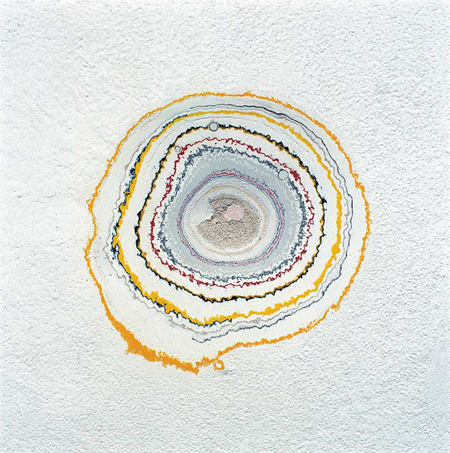
Installation view of a hole revealing wall painting of successive exhibition layers, 20 cm in diameter at the Viennese Secession. Like A geographical cross-section, Timekeeper uncovers and shows the successive layers left behind by previous actions (wall paintings) on the walls of the Wiener Secession. Just as the rings of a tree tell its history. Timekeeper is a caption that tells the story of its location. It allows the work of different artists to coexist. A kind of retrospective and group exhibition. 2003
“It’s very difficult to say what’s poetic in my work because it’s not something ‘mathematical’. It’s not a recipe. There’s no reason to have a recipe and say that I’m going to be poetic. I never do that. It’s rarely within the form itself. It’s more in the process. If there is something poetic, it’s poetic in the procedure . . . in the way things are made.”
– Pierre Huyghe
Maya Lin
Atlas Landscape, 2006
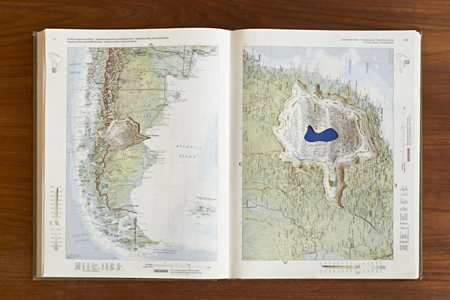
Caspian Sea, 2006
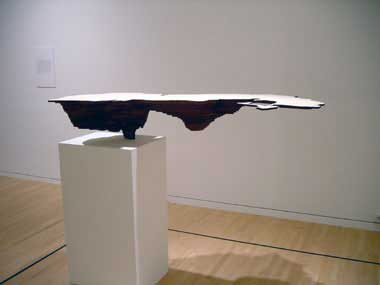
Posted in Stratigraphy, Visual Arts | Reacties uitgeschakeld voor Systematic Landscapes
januari 20th, 2009
Folded rock in Namib desert (Southern Africa)

When Einstein wrote his general theory of relativity in 1915, he found a new way to describe gravity. It was not a force, as Sir Isaac Newton had supposed, but a consequence of the distortion of space and time, conceived together in his theory as ‘space-time’. Any object distorts the fabric of space-time and the bigger it is, the greater the effect.
Just as a bowling ball placed on a trampoline stretches the fabric and causes it to sag, so planets and stars warp space-time – a phenomenon known as the ‘geodetic effect’. A marble moving along the trampoline will be drawn inexorably towards the ball.
Thus the planets orbiting the Sun are not being pulled by the Sun; they are following the curved space-time deformation caused by the Sun. The reason the planets never fall into the Sun is because of the speed at which they are travelling. According to the theory, matter and energy distort space-time, curving it around themselves.
- Anushka Asthana and David Smith, The Observer -
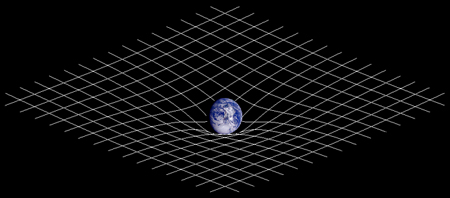
Two-dimensional analogy of space-time distortion.
Posted in Philosophy, Stratigraphy | Reacties uitgeschakeld voor Curved Space
december 30th, 2008
Nobuo Sekine
Phase — Mother Earth, 1968
(270 x 220 cm)
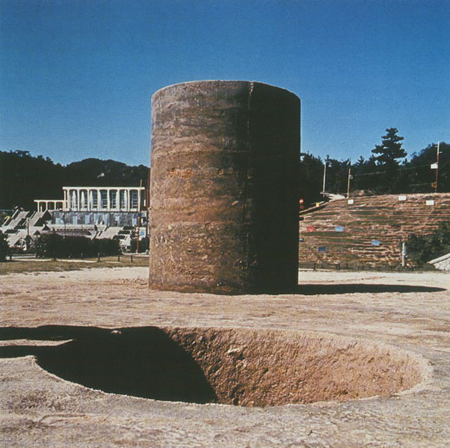
In October 1968 Nobuo Sekine dug a hole in the ground, shaped the extracted dirt into a large cylinder and called the work “Phase — Mother Earth.” It was probably an experiment, influenced by discussions of the new Land Art and Minimalist works taking place in the United States.
When it was first constructed, the prevailing view in Japan was that it was kind of quirky visual play of positive and negative spaces. But artist Lee Ufan disagreed, claiming that this was actually the end of visual manipulation; it was in fact a real time, real life absence and presence presented in temporal juxtaposition — a before and an after.
This, Sekine’s piece and Lee’s comment, is typically pointed to as the founding moment of Japan’s influential, homegrown Mono-ha art movement.
Born into the post-war years and the supposed ruins of consumer culture, a small group of artists were attempting to create a new, utopian reality. They proceeded as if art might be re-enchanted by shifting attention away from the objectification of images and to the creation of a world of encounters, with everyday objects, that might end up looking like mythic gestures.
Mono-ha, literally “the school of things,” was initially an informal term — sometimes used derisively — that brought together loosely affiliated artists around Tokyo including Sekine, Lee, Susumu Koshimizu, Katsuro Yoshida, and 12 or so others.
By MATT LARKING
Special to The Japan Times

“Faced with this solid block of raw earth, the power of this object of reality rendered everybody speechless, and we stood there, rooted to the spot… I just wondered at the power of the convex and concave earth, the sheer physicality of it. I could feel the passing of time’s quiet emptiness… That was the birth of ‘Mono-ha’. – Nobuo Sekine
Posted in Archaeology, Geology, Stratigraphy, Visual Arts | Reacties uitgeschakeld voor Sampling Mother Earth
november 6th, 2008
Maarten Vanden Eynde
Mon(NU)mentum, 2008 AD
(450 x 60 cm)

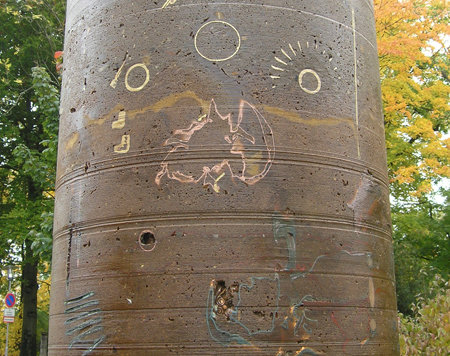
Time is a philosophical dimension, a basic substance which we breath in and out constantly. Just like space it is always there. Time experience however seems to be working on many different levels in an ever changing and more personalized speed (sometimes a minute can last forever and your life can fly by in a fraction). Time is not static, it is always on the move. The impossibility to stop time is mirrored by the impossibility to live in the present. ‘Now’ is an elusive point between the past and the future. Like the gardener on his way to Ispahaan, the present is on his way to an unavoidable destiny: the past. There is no escape. When you read THIS word, it became history already. The future is catching up instantly. What is the force that powers the engine of time? Is the present being pulled towards the future?
The Universal Law of Gravitation has several important features. First, it is an inverse square law, meaning that the strength of the force between two massive objects decreases in proportion to the square of the distance between them as they move farther apart. Second, the direction in which the force acts is always along the line (or vector) connecting the two gravitating objects.
In 1687 Sir Isaac Newton first published his Philosophiae Naturalis Principia Mathematica (Mathematical Principles of Natural Philosophy) which was a radical treatment of mechanics, establishing the concepts which were to dominate physics for the next two hundred years. Among the book’s most important new concepts was Newton’s Universal Law of Gravitation. Newton managed to take Kepler’s Laws governing the motion of the planets and Galileo’s ideas about kinematics and projectile motion and synthesize them into a law which governed both motion on earth and motion in the heavens. This was an achievement of enormous importance for physics; Newton’s discoveries meant that the universe was a rational place in which the same principles of nature applied to all objects.
Could it also work for Time?
Between two objects, let’s say A and B, there is a point where the gravitation of both objects is working with equal force (L1 point, named after Lagrange ). This point is balancing between the two attracting masses. If it is slightly bending towards A or B is will be attracted more by either one of them. It can only move from it’s frozen position, without loosing it’s equal balance, if A and B change mass simultaneously. The mass A is loosing, B has to gain. If time would be a linear experience, and A would be the past and B the future, than the point (C) hanging in the middle would be the present.
Presuming the past is getting longer and longer (or bigger and bigger), in order for C to be equally drawn to both A and B, it needs to be moving towards the future. The past is getting bigger and the future is getting smaller. And on top of that the speed of this process seems to be accelerating. With the population growth as exemplary model and driving fuel, evolution takes place at an unprecedented speed. New inventions and discoveries changing the world beyond recognition are constantly coming closer after each other. Just like the birth of matter during the big bang, time was created at the same moment and moves equally with the expanding universe; faster and faster to it’s final destiny.
The installation ‘Mo(NU)mentum’ is made up of several layers of history, creating a massive pillar. The drill core is like a sample of time, taken from the earth in the future to understand how the world evolved. Starting with a massive block of stone (in which the different geological layers are visible) the drill core contains samples of wood, copper, metal, bricks, concrete, asphalt, tar and plastic. The layers are getting thinner and thinner the closer they get to the present = the plastic layer. So far the materials created a foundation for the next, but the plastic layer is so thin and vulnerable that it is impossible to continue from there. It is a final moment in present evolution.
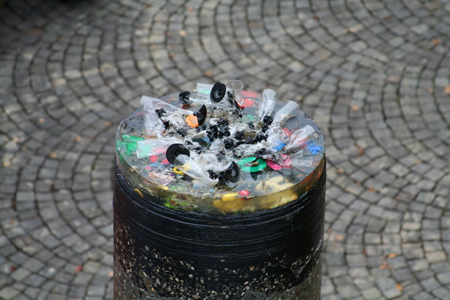
Mo(NU)mentum is a monument for the future, visualizing the impossibility to continue the current evolution. It is a permanent memory and trace of Generali Groups Executive Forum on Time: Business Opportunity and Strategic Timing. The best Champagne was served in plastic Champagne glasses. The empty glasses were collected and melted on top of the installation, thereby physically contributing the last layer.
Posted in Archaeology, Barology, Horology, Stratigraphy, Visual Arts | 4 Comments »
maart 24th, 2008
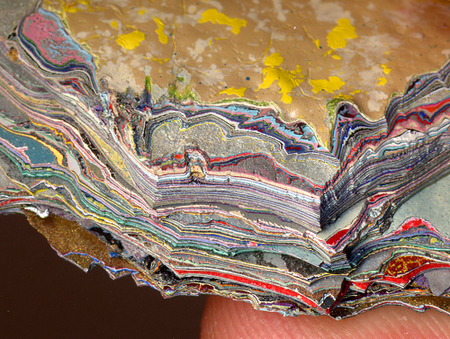
This is an extreme closeup scan (2400 dpi) of a paint chip retrieved from the ruins of Belmont Art Park from a piture taken by Amy McKenzie earlier this year. The fragment is about 1cm thick, and appears to consist of about 150-200 layers of paint.
Egyptian Theatre, Los Angeles
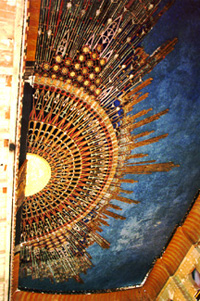

The construction team currently restoring the 1922 Egyptian Theater, the American Cinematheque’s future home on Hollywood Boulevard, is engaged in a peculiar form of archeological excavation. Bound by federal laws dictating what renovations are permissible within a designated historic landmark and required to create a space suitable for contemporary media arts exhibitions, the workers peel back layers of piaster, paint and drywall. In the process they have revealed fragments of a 1960s-era mural, a hybrid of psychedelic and Egyptian styles, and, several layers beneath this, what remains of the original pastel and art deco ’20s decor. The excavation of successive false fronts and simulations suggests an architectural model for urban memory. Each layer reworks not a lost original but rather a prior approximation.
Posted in Archaeology, Stratigraphy, Visual Arts | 1 Comment »
januari 16th, 2006
During the 1993 Long Beach Earthquake in Los Angeles, USA this coastalroad was destroyed. Wind and water have taken over the area and transformed it into a modern acheological site. A new geological layer is added on top of the others; concrete and asfalt.
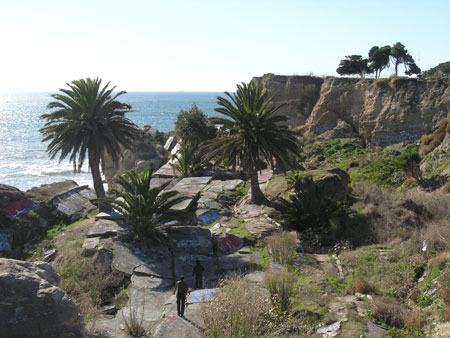
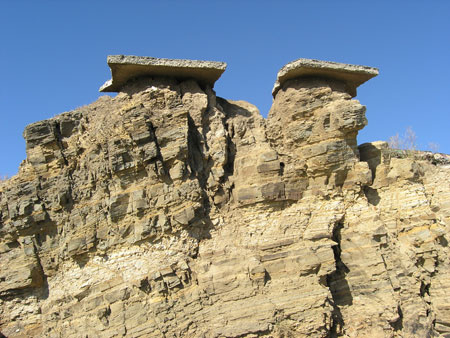
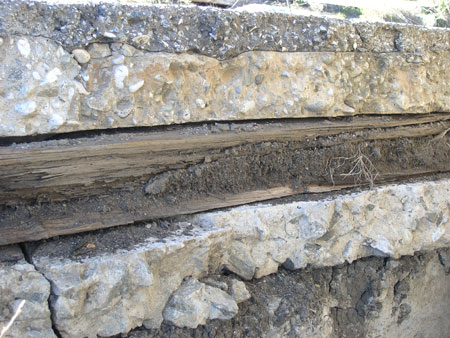
Posted in Archaeology, Stratigraphy | Reacties uitgeschakeld voor The Long Beach Earthquake of 1933















